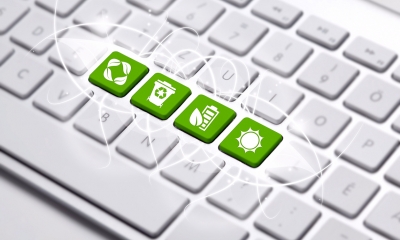
Reducing the environmental impact of your business isn't just the right thing to do or a question of meeting your legal obligations. It also offers substantial and immediate business benefits, including reducing your costs and improving your reputation.
A thorough environmental review is an ideal starting point. Identifying the major impacts of your business allows you to prioritise the best opportunities for improvements. Scheduling regular reviews allows you to monitor how well you are doing and identify new areas to focus on.
1. Get organised
Decide who will be responsible for environmental reviews
- Even if you delegate responsibility for conducting the review, you still need a top-level commitment to improving your environmental performance.
Involve employees throughout the business
- Ask your staff to look at their own jobs, identifying wasteful and environmentally harmful working practices.
- Encourage employees to come forward with suggestions about how the business overall can reduce its environmental impact. Make it easy for them to report problems: for example, leaking taps or rusting storage bins.
- Encourage employees to take environmental issues seriously by responding to their comments and suggestions.
Get background information and arrange any help you need
- Reviewing your legal obligations to the environment can help you identify some of the key issues to consider.
- The Carbon Trust offers free publications to help you identify and reduce wasted energy.
- WRAP offers free publications on improving resource efficiency and reducing waste throughout your business.
- It may be worthwhile paying for an environmental consultant, particularly if your business has a significant environmental impact or risks (eg in sectors such as manufacturing and agriculture).
Decide when to conduct reviews
- Schedule regular reviews - perhaps annually - to help monitor your environmental performance and set new objectives.
- You may want to conduct additional environmental assessments before getting involved in new activities or making significant investments in new equipment.
Be thorough
- Take into account all your business activities and all parts of your premises.
- Assess how activities and environmental impacts vary at different times of the day and when starting up or closing down different activities (eg firing up an incinerator).
- Consider the possible environmental impact of accidents and emergencies.
- Use your records as part of your review: for example, energy and water bills, raw material costs, waste disposal records, and so on.
Be realistic
- Assess the environmental impact of the way your business actually operates, rather than assuming that correct procedures are always followed.
2. Raw materials and water
Assess the environmental impact of the raw materials you use
- Check whether any of your raw materials present particular environmental risks - for example, toxic chemicals.
- Consider whether there are more environmentally friendly alternatives - for example, using recycled paper and biodegradable cleaning products or packaging that is simple to recycle.
Check how you store materials
- Efficient storage minimises breakages and other losses, so reducing waste.
- Potentially hazardous materials, such as oils, need special storage to minimise the risk of pollution.
Assess your use of water
- The environmental impact of using water can be substantially increased if you discharge polluted water into the sewers or allow it to run off from your property (see Pollution and emissions).
Take regular measurements to track your use of raw materials and water
- Raw material costs and water bills (including sewage charges) provide overall indicators of total impact.
- Relating costs to overall output provides guidance on the efficiency with which you are using these resources.
3. Energy
Identify where you use energy in your business
- Heating, lighting and production processes tend to be energy-intensive activities.
- You may use substantial energy in business travel or transporting goods.
Look for obvious waste
- Check at different times of day to see whether you are leaving heating, lighting and machinery on (or on standby) unnecessarily.
- Make sure power is not wasted heating and lighting rooms when they are not being used - for example, at the weekend.
- Check that your heating is adequate - but not excessive.
- Make sure you are using natural light and energy-efficient lighting wherever possible.
Assess heat loss in your premises
- Consider whether you have adequate insulation, including double or triple glazing and draught proofing.
- Check whether any equipment or parts of the premises that need to be maintained at different temperatures are properly insulated.
Ensure equipment and premises are properly used and maintained
- Regular servicing can more than cover its costs through improved energy efficiency.
- Computers and other types of equipment can be set up in energy-saving mode.
- Look for obstructions in front of radiators and doors or windows left open.
Establish how efficient your energy use is
- Monitor energy bills and how energy costs per unit of output are changing.
- Check the age of equipment and its energy efficiency. Energy savings from newer, more efficient equipment might more than compensate for the investment required to replace old equipment.
4. Pollution and emissions
Identify any high risk or high-volume emissions you produce
- Burning fuel (eg in a furnace) or waste can have a substantial environmental impact and may require regulatory approval.
- Review any production processes, particularly any involving solvents, volatile organic compounds or other chemicals.
Assess any other emissions or pollution from your premises
- Simple inspection will detect many emissions - for example, smoke, dust, smells, noise and so on.
- Take into account how these are likely to affect any neighbours or your local environment.
Identify how water leaves your premises
- Consider whether contaminated water is produced by any of your production processes. If you produce trade effluent, you should have authorisation before discharging it into the sewerage system.
- Rainwater may become contaminated before running off into drains or local surface or groundwater.
Try to establish appropriate indicators of pollution and emissions
- You may need to carry out tests - for example, measuring levels of contamination in effluent.
5. Waste
Identify the waste you produce
- Question whether you are producing unnecessary waste. For example, you might be able to design more efficient production processes, or reuse or recycle waste products.
Review how you store waste
- Storing different types of waste separately will make it easier to recycle.
- Identify whether your stored waste causes an environmental nuisance - for example, poorly stored food waste.
- Check that waste is securely stored to minimise the risk of contamination in case of an accident.
Confirm that your waste is properly treated and disposed of
- Check that your waste disposal contractor is properly authorised to treat and dispose of the waste you produce.
- Consider taking specialist advice if your business produces hazardous waste.
Establish and monitor key indicators of your waste production
- For example, you might monitor levels of waste in your production processes, and total waste-disposal costs.
6. Your supply chain
Consider how the suppliers you use affect your overall environmental impact
- Your choice of suppliers can make a big difference - for example, choosing suppliers who use sustainable resources and environmentally sound working practices.
- Transporting supplies over long distances produces high levels of emissions. Onward delivery of your products through the supply chain also produces emissions.
Decide how best to monitor the impact of your supply chain
- One option is to ask suppliers to provide information on their environmental performance and policies.
- Some businesses (and public sector organisations) prefer to use suppliers who meet a recognised standard. For example, you might only purchase timber that has been certified as sustainable or deal with suppliers with an environmental management system that is registered to the ISO 14001 Standard.
- If a supplier's performance is critical to your environmental impact, and if the costs are justified by the scale of your business, you may want to work with the supplier to assess and reduce their environmental impact.
7. Your products
Consider how the use of your products impacts on the environment
- For example, if you produce machines, the energy they use in service may be substantially greater than the energy used to produce them. Designing more energy-efficient machines might be your single biggest opportunity to help the environment.
Take into account the impact of packaging
- Assess whether you use excessive packaging and how easy it is to recycle.
Take into account disposal of your products
- Consider the environmental impact of your products when they reach the end of their working lives
- Products that can be easily recycled will be relatively environmentally friendly.
- Ecodesign regulations require manufacturers to make certain appliances relatively energy-efficient and easy to repair.
8. Take action
Make the most of simple, quick opportunities
- Very simple opportunities can include using energy-efficient light bulbs or turning the thermostat down one degree.
- In offices, printing on both sides of the paper and in black and white when possible - and using email instead of post - are easy ways to cut waste.
- Automated systems can help reduce the waste caused by poor working practices. For example, seven-day timers can ensure that you do not accidentally leave heating and lighting on overnight or at the weekend.
Identify the priorities
- As a minimum, you must meet your legal obligations.
- Look for the biggest opportunities to benefit the environment and your business. The substances and processes that have the biggest environmental impact are often those where you can make the biggest cost savings.
- Consider benchmarking yourself against other similar businesses or industry standards to identify your weakest areas.
Set objectives
- Wherever possible, include measurable goals and deadlines - for example, reducing waste by a stated percentage before a given date.
- Make sure employees have the training and motivation to help the business achieve these goals.
Consider introducing an environmental management system
- An environmental management system can help you ensure that you follow through systematically and continuously improve your environmental performance.
Signpost
- Download The journey to net zero guide for SMEs from the Carbon Trust.
- Find resource efficiency resources from WRAP.
- Find Environment Agency services and information for businesses in England and Wales (03708 506 506).
- Find Scottish Environment Protection Agency services and information (03000 99 66 99).
- Get information from the Northern Ireland Department of Agriculture, Environment and Rural Affairs (0300 200 7852)



